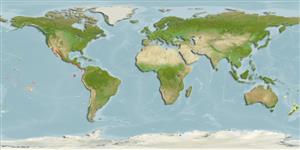Malacostraca |
Decapoda |
Sicyoniidae
Environment: milieu / climate zone / depth range / distribution range
Ecology
Benthic; depth range 3 - 100 m (Ref. 83922). Tropical; 29°N - 19°S, 112°W - 71°W
Eastern Pacific: Mexico to Chile.
Length at first maturity / Size / Weight / Age
Maturity: Lm ? range ? - ? cm Max length : 9.87 cm TL (female)
Occurs in the coast (Ref. 121706), in the continental shelf (Ref. 112661, 121706), rarely found in waters deeper than 65 m (Ref. 112661). Found on mud (Ref. 83922), sand (fine and very fine),silty sand (Ref. 121706), detritus, rocks and coral (Ref. 112661). Also found in estuary (Ref. 121715).
Life cycle and mating behavior
Maturity | Reproduction | Spawning | Eggs | Fecundity | Larvae
Members of the order Decapoda are mostly gonochoric. Mating behavior: Precopulatory courtship ritual is common (through olfactory and tactile cues); usually indirect sperm transfer.
Pérez Farfante, I. and B. Kensley. 1997. (Ref. 75620)
IUCN Red List Status (Ref. 130435)
CITES status (Ref. 108899)
Not Evaluated
Not Evaluated
Threat to humans
Human uses
Fisheries: commercial
| FishSource |
Tools
More information
Age/Size
Growth
Length-weight
Length-length
Morphology
Larvae
Abundance
Internet sources
Estimates based on models
Preferred temperature
(Ref.
115969): 17.7 - 28.6, mean 23.4 (based on 110 cells).
Price category
Unknown.
